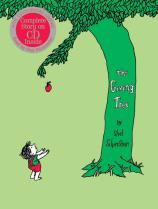 One of the most celebrated picture books of all time is THE GIVING TREE by Shel Silverstein. However, people have very different perceptions about what makes it so special, and how one's opinion about the book changes as they grow older.
One of the most celebrated picture books of all time is THE GIVING TREE by Shel Silverstein. However, people have very different perceptions about what makes it so special, and how one's opinion about the book changes as they grow older.
Below, we have two posts by Teen Board Members about the book. The first, written by Sydney L., explains that she loves the book because it can be interpreted in so many different ways. In the second post, Maya B. talks about how her opinion about the book changed as she got older, and why the message she takes from it is so close to her heart.
Read both posts below, in honor of National Picture Book Month!

One of the interesting things about this story is how different its art is from other stories. So often picture books rely on bright, elaborately drawn illustrations to capture young readers’ attention, but in THE GIVING TREE, like all of Silverstein’s other books, the drawings are simple and black and white, and still manage to entertain all who read it. The fact that such doodles can still be regarded as a childhood classic is incredible because it shows the story is read to appreciate the boy and the tree’s story, not just color schemes. It allows the readers to understand the story’s theme much better and form opinions based on that.
Despite the fact that the story is basic, there are dozens of different opinions on how it can be interpreted. Some think that the tree and the boy are actually symbols of the creator giving his creations all he can. Others think it is a way to show children the things their parents do for them through metaphors. Still others sees the tree as a symbol of how we’ve robbed Mother Nature for our own greed. Many see the characters’ relationship as a depiction of selfless love due to the tree’s generosity. On the other hand, the boy’s conceit and “selfish receiving” mark the book as a negative one-sided love to some readers. It honestly just depends on how you choose to view Silverstein’s classic, and that is definitely an interesting aspect of the book: you can put so much thought behind the few words the book consists of.
Despite the fact that the story is basic, there are dozens of different opinions on how it can be interpreted.
One of the most agreed upon messages of the book is that there are ways to show love to those you care about other than just words. I think that idea, though written in 1964, is still --- if not more --- relevant in today’s society. It reminds us that love should be shown by simple actions and that sometimes our happiness is not the only thing that matters. That is exactly why this book is special to me.
Sydney L. is a Teen Board Member
THE GIVING TREE by Shel Silverstein used to be my favorite book. I loved seeing the boy grow older, start his own life, and come to visit the tree sometimes. I loved that the Giving Tree was always happy. I just didn’t understand how high the price of the tree’s happiness was.
There shouldn’t have to be such a price for happiness, yet the tree didn’t seem to realize this. The boy was taking advantage of the tree, literally cutting her down and destroying her. The tree shouldn’t have been happy. The tree shouldn’t have had to sacrifice herself for another’s needs, especially for one that didn’t appreciate it. Even so, when I was a kid, maybe about six or seven, I didn’t feel sad for the tree when I read the book.
Most kids don’t understand the hidden context, the feelings that aren’t said. When the tree said that she felt happy, I didn’t second guess it. If the tree had said that she felt angry, or frustrated, I would have believed her then, too. However, I really do think that the tree was happy, and that’s what makes me so sad now. Many victims in an abusive relationship may give until there’s nothing left. They don’t stomp away and leave. They’re happy. They’re happy even though all their branches are gone and they’re all alone. As long as everyone else is happy, they will silently suffer in a thing they call happiness.
That’s when I realized the tragedy of the story: the tree’s happiness was misguided and half empty.
I don’t think that kids understand this when they’re reading this book. I know I didn’t. It came to me later sitting in bed reading it for the billionth time. The boy had taken all her apples and cut down all her branches to build a house, and the tree told him to cut her down entirely to make a boat. So he chopped down her trunk and sailed away. And then I started to cry. That’s when I realized the tragedy of the story: the tree’s happiness was misguided and half empty.
Happiness or love is not servicing others in expense of yourself. It is not only loving others and giving to others. It’s also giving to and loving yourself. That’s the thing that the Giving Tree didn’t understand.
Maya B. is a Teen Board member.


